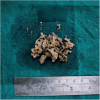Spinal teratoma in an adolescent: a rare case report with intradural presentation and review of management strategies
- PMID: 40787529
- PMCID: PMC12333716
- DOI: 10.1097/MS9.0000000000003561
Spinal teratoma in an adolescent: a rare case report with intradural presentation and review of management strategies
Abstract
Introduction: Spinal teratomas are rare tumors of pluripotent germ cells, accounting for <0.5% of all spinal cord tumors and 2% of all teratomas. While they commonly occur in gonads, extragonadal spinal presentation is uncommon. They are often associated with spinal dysraphism and present variably depending on tumor location and neural compression. MRI aids in diagnosis, but histopathological examination remains the gold standard. Early detection is vital to avoid irreversible neurological damage.
Case presentation: A 16-year-old Indian male presented with progressive lower back pain for one year, followed by involuntary micturition and bilateral temporal headaches for six months. Neurological examination was normal, but persistent urinary symptoms warranted imaging. MRI revealed an intradural lesion at D11-L1, consistent with a spinal teratoma. The patient underwent surgical excision, and histopathology confirmed a monodermal teratoma. At three-month follow-up, the patient's symptoms had completely resolved.
Discussion: Spinal teratomas may be classified as mature, immature, or malignant. Mature teratomas are most common in adults. Theories regarding their origin include misplaced primordial germ cells and dysembryogenic malformations. Clinical presentation varies from pain to autonomic dysfunction, demanding high clinical suspicion and prompt imaging. Surgical excision remains the mainstay of treatment. Subtotal resection is considered when tumors adhere to critical neural structures. Although rare, recurrence, malignant transformation, and aseptic meningitis have been reported, emphasizing the need for long-term follow-up.
Conclusion: This case underscores the importance of early neuroimaging in patients with atypical spinal symptoms. Surgical resection is definitive, while histopathology confirms the diagnosis. Regular follow-up remains essential.
Keywords: aseptic meningitis; intradural tumor; monodermal teratoma; spinal teratoma; surgical excision.
Copyright © 2025 The Author(s). Published by Wolters Kluwer Health, Inc.
Conflict of interest statement
Sponsorships or competing interests that may be relevant to content are disclosed at the end of this article. The authors declare no conflict of interest.
Figures



References
-
- Khalighinejad F, Hajizadeh M, Mokhtari A, et al. Spinal intradural extramedullary dermoid cyst. World Neurosurg 2020;134:448–51. - PubMed
-
- Senapati D, Mishra S, Shukla NK, et al. Long-segment intradural extramedullary teratoma of dorsolumbar spinal cord in an adolescent: a rare tumor with review of literature. Neurol India 2023;71:760–63. - PubMed
-
- Schmidt RF, Casey JP, Gandhe AR, et al. Teratoma of the spinal cord in an adult: report of a rare case and review of the literature. J Clin Neurosci 2017;36:59–63. - PubMed
Publication types
LinkOut - more resources
Full Text Sources
